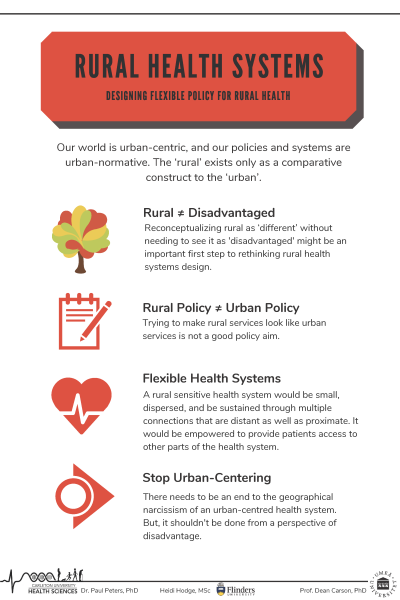 In a recent commentary published in the University of Toronto Medical Journal I argue that we need to broaden the narrative on rural health. In this commentary, I claim that in order to be sensitive and relevant, rural health research must change the perspective through which it views rural people and rural communities. First, rural communities are dynamic and not static, and change is a normal condition in small villages as much as it is elsewhere. Second, rural communities should be approached through a lends of resilience rather than disadvantage. Third, rural does not exist only in contrast to the urban. Fourth, there are implications of these theoretical shifts for health systems, health research, healthcare, and the methods we use to study these structures. This brief post expands on the implication for this perspective on rural health to how we understand rural health systems.
In a recent commentary published in the University of Toronto Medical Journal I argue that we need to broaden the narrative on rural health. In this commentary, I claim that in order to be sensitive and relevant, rural health research must change the perspective through which it views rural people and rural communities. First, rural communities are dynamic and not static, and change is a normal condition in small villages as much as it is elsewhere. Second, rural communities should be approached through a lends of resilience rather than disadvantage. Third, rural does not exist only in contrast to the urban. Fourth, there are implications of these theoretical shifts for health systems, health research, healthcare, and the methods we use to study these structures. This brief post expands on the implication for this perspective on rural health to how we understand rural health systems.
These ideas were first brought forth by Professor Dean Carson and we previously summarized here in an infographic presented at one of our Free Range workshops. It’s also available to download as a PDF.
Given the complex and dynamic nature of rural communities, how should health research be conducted, health services provided, and health policy developed? Anecdotal evidence suggests that rural communities are in a perpetual state of demolition, with a reduction in services, closure of hospitals, loss of physicians, etc. As a population declines (or fails to grow), how does a government continue to support a 20-bed hospital facility? With limited opportunity for families or spouses, how do small villages retain a family physician? How are prenatal and postnatal care provided when there may only be 2-3 births per year? These questions cannot be answered from an urban-normative lens, where uniform policies and programs are applied to each community.
For health researchers and practitioners, addressing the above points may require getting out of one’s comfort zone. For health policymakers, this may mean that policies need to be more flexible and less prescriptive, with allowance for adaptation and failure, as promoted in complex systems and antifragile research for eHealth implementation in Northern Sweden.
For quantitative researchers (my own domain), this shift may require involving rural residents in research design, analysis, and interpretation, and spending time living and working in the communities under study. There may be instances where the quantitative data is insufficient or where findings don’t match with theory. In these cases, the lived experience of rural residents and the ‘thick’ knowledge that comes from understanding the communities under study can assist.
 One logical extension when considering this perspective of rural communities and health systems is that parts of the system can’t be viewed in isolation. One can’t examine hospitalization rates without considering access to primary care, which can’t be considered without looking at recruitment and retention, which requires an understanding of community resilience. Similarly, hospitalization rates are influenced by the social demography of the underlying population, which in rural communities may be related to colonization of indigenous populations, regional economic trends, internal migration patterns, and even shifts in international immigration.
One logical extension when considering this perspective of rural communities and health systems is that parts of the system can’t be viewed in isolation. One can’t examine hospitalization rates without considering access to primary care, which can’t be considered without looking at recruitment and retention, which requires an understanding of community resilience. Similarly, hospitalization rates are influenced by the social demography of the underlying population, which in rural communities may be related to colonization of indigenous populations, regional economic trends, internal migration patterns, and even shifts in international immigration.
To address this, our research lab and international collaborators have made this type of rural research a priority. We explicitly integrate a diversity of perspectives from multiple locations. We’ve done this through our funded research projects and published books and require this for our trainee scholars through our Free Range program.
Over the coming months, we’ll be presenting some research examples and personal perspectives in this blog series. The hope is that this will provide a resource for other scholars who share our perspectives, and provide a challenge to us (and others) who may disagree.
Until later,
Paul